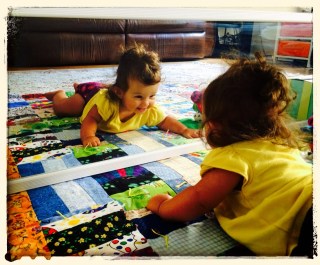I don’t know about you, but our kids always seem to have too much stuff….too many stuffed animals, too many dolls, too many plastic play sets, too many puzzles, etc. When L is going to a birthday party, I hate to buy a toy that her friend will play with for 5 minutes and then toss to the side. Homemade gifts are truly the best, most heart-felt to give and I love making them, but I just don’t have the time some days. The IMAGINATION BOX is my gift-giving solution!!! It is quick and easy to put together and kids of all ages LOVE it! The Imagination Box makes for a fun birthday gift, as well as a perfect “Get Well Soon” gift, plus it guarantees hours of entertainment!

“So, what do I put in the box?” you ask. Anything and everything!
Paper plates and cups, brown paper bags, construction paper, crepe paper, straws…

Cotton balls, clothes pins, colored craft sticks, paper clips, sponges, markers, googlie eyes…

Buttons, rubber bands, glue, beads, shoe laces, pipe cleaners…

Egg cartons, kid scissors, mini-staplers, felt squares, a few sandwich bags (for lil pieces with opened packaging)…

Just about anything that will fit in the Imagination Box, that kids can use to create art, works! I usually go to the Dollar Store, walking up and down every aisle, and look for items with crafting potential. It certainly looks like a lot pictured here, but the box can be filled with less than 25 dollars!

Last, but not least, you need a cardboard box to put everything in. Try to leave the box mostly undecorated, so the child receiving the gift can use it too! The box itself will make a perfect rocketship, firetruck, castle, table, bed, gnome house, etc.

When putting together an Imagination Box, you need to consider the child’s age. It’s best to put things in the box that the child receiving it can create with independently and safely. After all, the box is designed to keep kids busy creating (so mom and dad can cook dinner in peace)! For instance, if you’re making an Imagination Box for a 2 yr old, you may not want to include scissors or a stapler, but an 8 year old would have no problem with them. Always make sure you give parents a heads-up of anything that’s questionable.
Some ideas to get kids started…
- make a little town or fairy village using paper bags
- paper plate masks
- pipe cleaner bracelets, necklaces, glasses
- puppets
- robots
- make pretend food
- cotton balls for clouds
- clothespins to make people
- egg carton flowers
- egg carton caterpillar
Get messy and have fun!!! Let the kids’ imaginations soar!








































































































